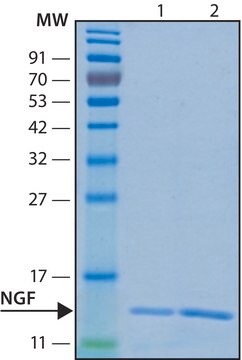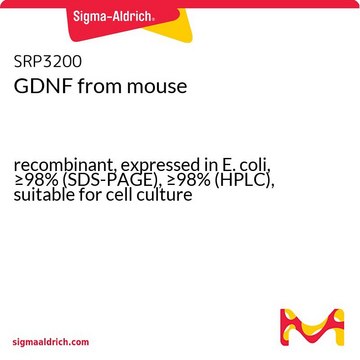N6009
Nerve Growth Factor-2.5S from murine submaxillary gland
lyophilized powder, suitable for cell culture
Sinónimos:
NGF-2.5S
About This Item
Productos recomendados
product name
Nerve Growth Factor-2.5S from murine submaxillary gland, NGF-2.5S, lyophilized powder, suitable for cell culture
origen biológico
mouse
Nivel de calidad
formulario
lyophilized powder
potencia
0.1-30 ng/mL EC50 (using PC-12 cells)
mol peso
26.5 kDa
envase
pkg of 4X25 μg
condiciones de almacenamiento
avoid repeated freeze/thaw cycles
técnicas
cell culture | mammalian: suitable
Nº de acceso UniProt
Condiciones de envío
dry ice
temp. de almacenamiento
−20°C
Información sobre el gen
mouse ... Ngf(18049)
Descripción general
Aplicación
- in Ham′s F-12 medium for performing growth cone collapse assay using dorsal root ganglions (DRGs)
- as a media supplement in the “process compartment” for microfluidic chamber studies
- to treat mid-luteal cells to study its effect on choline acetyltransferase (CHAT) expression
Acciones bioquímicas o fisiológicas
Otras notas
Forma física
Nota de análisis
Código de clase de almacenamiento
11 - Combustible Solids
Clase de riesgo para el agua (WGK)
WGK 3
Punto de inflamabilidad (°F)
Not applicable
Punto de inflamabilidad (°C)
Not applicable
Equipo de protección personal
Eyeshields, Gloves, type N95 (US)
Certificados de análisis (COA)
Busque Certificados de análisis (COA) introduciendo el número de lote del producto. Los números de lote se encuentran en la etiqueta del producto después de las palabras «Lot» o «Batch»
¿Ya tiene este producto?
Encuentre la documentación para los productos que ha comprado recientemente en la Biblioteca de documentos.
Nuestro equipo de científicos tiene experiencia en todas las áreas de investigación: Ciencias de la vida, Ciencia de los materiales, Síntesis química, Cromatografía, Analítica y muchas otras.
Póngase en contacto con el Servicio técnico








